Dreaming of sailing to Hawaii is one thing, actually embarking on the journey is entirely different. The amount of details that go into such a campaign is truly overwhelming. Such an endeavor takes time and money, and we were short on both. This segment focused on what it took us to make Hamachi race ready and get her to southern California in advance of the race.
Many boats start preparing for a race like Transpac a year in advance. Due to life circumstances we committed to this adventure late, only four months before the start. We signed up on March 2nd, which was the last day before you had to pay a late penalty. Our start was July 12th.
Our boat Hamachi has been raced to Hawaii twice before so it was “offshore ready”. Still, preparation requires recertifying all of the safety / survival gear, checking all of the equipment on the boat and replacing many items. Then there is the logistics of moving it from Seattle to Southern California. On top of this is the process of selecting the crew and doing enough training events to make sure everyone is ready to race hard for 7-10 days across the Pacific Ocean. It took one person full time, and others contributing, for two and a half months to get the boat prepped and to Southern California, and even then there is a lengthy list of small To Do items.
Boat, Sails and Rigging: Our sail inventory was built for the 2014 Pacific Cup and saw use in the 2015 Transpac and a few other offshore events. It was state of the art when produced and since purchasing the boat in late 2016 we have hardly used the offshore sails, so they were in good condition. We struck up a partnership with Samson Rope and replaced key lines: new jib, spinnaker and main halyards, as well as new spinnaker sheets. We also replaced key through deck hardware and then tore the boat apart and resealed everything to minimize water incursion.
Safety Equipment: The offshore racing community has learned from previous tragedies and developed a rigorous set of standards for inshore and offshore races. As a result there is a lengthy checklist of required sailing safety equipment that each boat must possess. For Hamachi, this includes a six man life raft, a Man Overboard Module, life slings, flares and other signal equipment, jack lines for clipping into the boat, safety tethers, self inflating life preservers equipped with lights, whistles, and electronic personal location beacons, an EPIRB (satellite communication device) to notify the USCG if things really go wrong. All of this equipment needed to be checked, certified, and/or upgraded. In addition there is mandatory MOB (Man Over Board) training that the crew must perform and at least one third of the crew needed to have Safety at Sea and First Aid / CPR accreditation.
Navigation Equipment: It’s 2250 miles (as the crow flies) from Los Angeles to Honolulu. When you cross the halfway point, you are one of the farthest distances from land on the planet. It’s easy to get lost out in the Pacific. As a result Hamachi has six different GPS based location devices which feed different systems for calculating position, speed, heading, etc. Winning a race like Transpac requires navigating the shortest route with the most wind. This is done by looking at weather information and optimizing a route that has the most “pressure”. We installed an Iridium GO satellite modem to communicate with shore and download publicly available weather information. This information is fed into two new (used) Panasonic Toughbook Tablets which run the Expedition navigation software, which is the race standard. This system requires a lot of integration and testing, which we accomplished on our transit south from San Francisco to Los Angeles.
Crew Selection: Transpac is one of those epic races that everyone dreams of racing in. However, finding crew members who can dedicate the time and money to participate can be challenging. Your biggest contribution to boat weight is crew, and all of the food and water it takes to support them. Less is more. Most J/125’s race with five or six total crew. We decided to be conservative on crew size given it was our first crossing, so we went with six. Given our experience level we wanted to have one very experienced “salty dog” on board, and then a lot of youthful energy with sailing expertise. Our crew is comprised of the following:
- Jason and Shawn: The owners of Hamachi who have spent the last 2.5 years learning the boat and dialing her in. We have been working up to Transpac by doing the VanIsle 360 (race around Vancouver Island) in 2017 and crewed a J/109 for the ChicagoMac (race across Lake Michigan) in 2018.
- Frederic: Our “salty dog” with over 250,000 ocean miles on his resume. He was the bowman of the French America’s Cup boat in the 1970s and has many Pacific crossings.
- Lucas: Fred’s son who grew up on boats in the South Pacific. He’s an accomplished local racer and boat owner as well as satellite builder. He has been a member of the Team Hamachi racing program since the beginning.
- Matt: Longtime family friend of Fred and Lucas. Matt has been sailing his whole life and is a world class small boat sailor.
- David: Our Navigator and alumnus of the NC State sailing team. He’s a local software programmer and regular member of the Team Hamachi racing program.
Crew Training: Despite being 41 ft long, a J/125 is still a small boat. It is long and narrow with low cabin ceilings so the interior is not much bigger than a minivan. As a result, crew chemistry is critical when you are going to live together for 7-10 days in cramped quarters driving a boat and yourself to its limits. We set two training events to test out this chemistry: a local overnight race called Protection Island and then a crew sail down the California coast from San Francisco to Los Angeles. As luck would have it mother nature delivered for both events and we had heavy weather (high winds) at times to test our collective boat handling skills and observe how everyone worked together in sometimes stressful situations. This crew is ready to go.
Moving the Boat: There are many ways to position a boat for Transpac. We have a trailer so we decided to disassemble the boat and drive it to San Francisco, then put it back together and sail it the rest of the way as a crew training event. We pulled the boat at CSR Marine and put it on its trailer, which was a first for us. Once out of the water we discovered several items that needed attention, which delayed our drive south several days and required heroics on the part of the team. The boat comes apart fairly easy but the first time is always an adventure. Mike Leslie sailed with the previous owner and has been with the Hamachi program for many years and was invaluable in getting the boat disassembled, down to California, and reassembled. He and I drove it down Interstate 5, which was a 20 hour adventure, using his Chevy 3500HD and then spent another 30 hours putting it back together at KKMI in Richmond, CA.
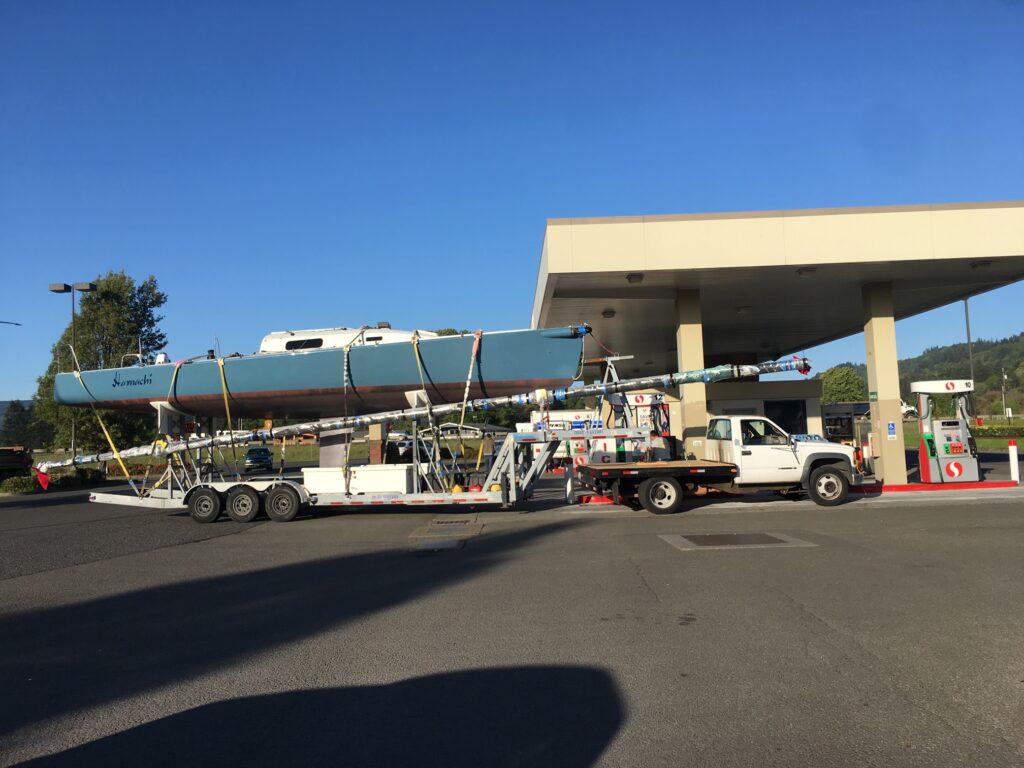
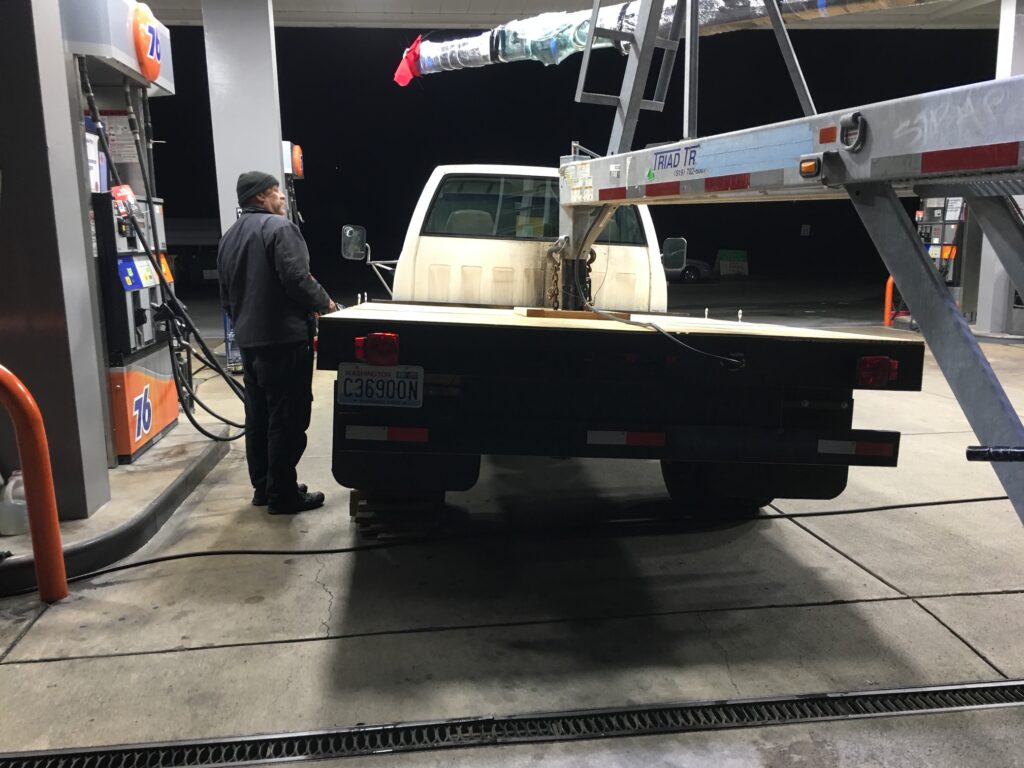
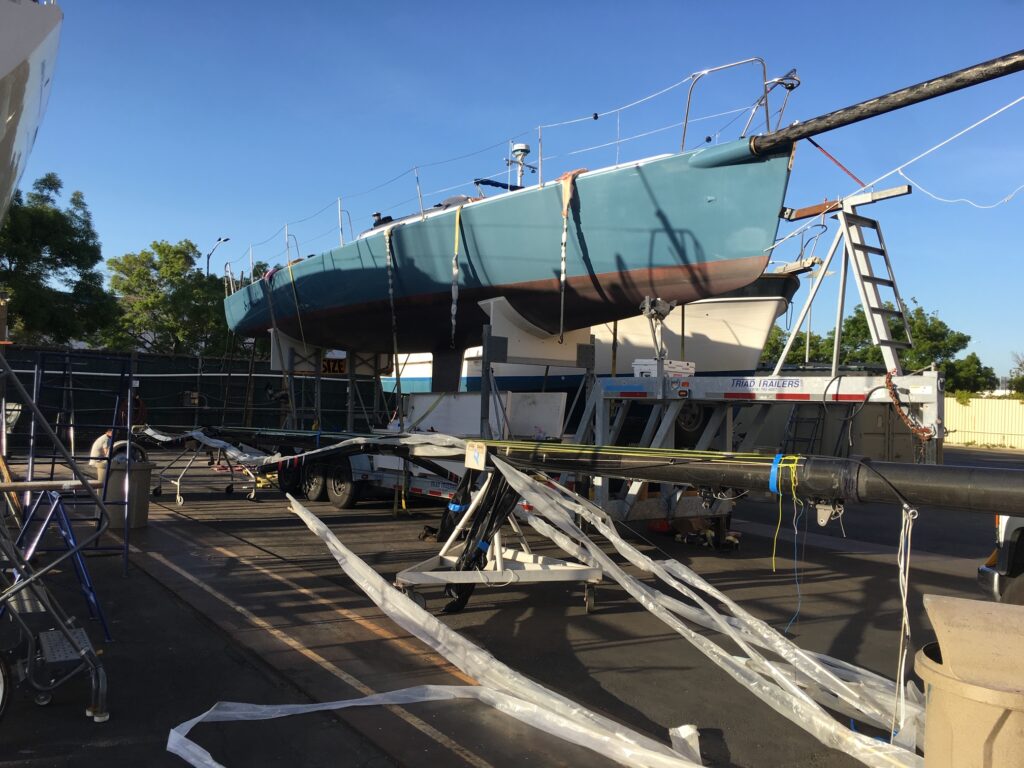

The boat was launched and the mast stepped, but we were delayed in moving it by large regattas in the Bay Area that had all of the marinas at over capacity. We were able to stash the trailer to await future transport to San Diego, from where it will be shipped to Hawaii. Mike drove the truck north while I stayed and was eventually able to move the boat to the Richmond Yacht Club, where it sat for a week next to the other J/125’s Velvet Hammer and Reinrag2, waiting for the crew to arrive the following weekend for the delivery south.
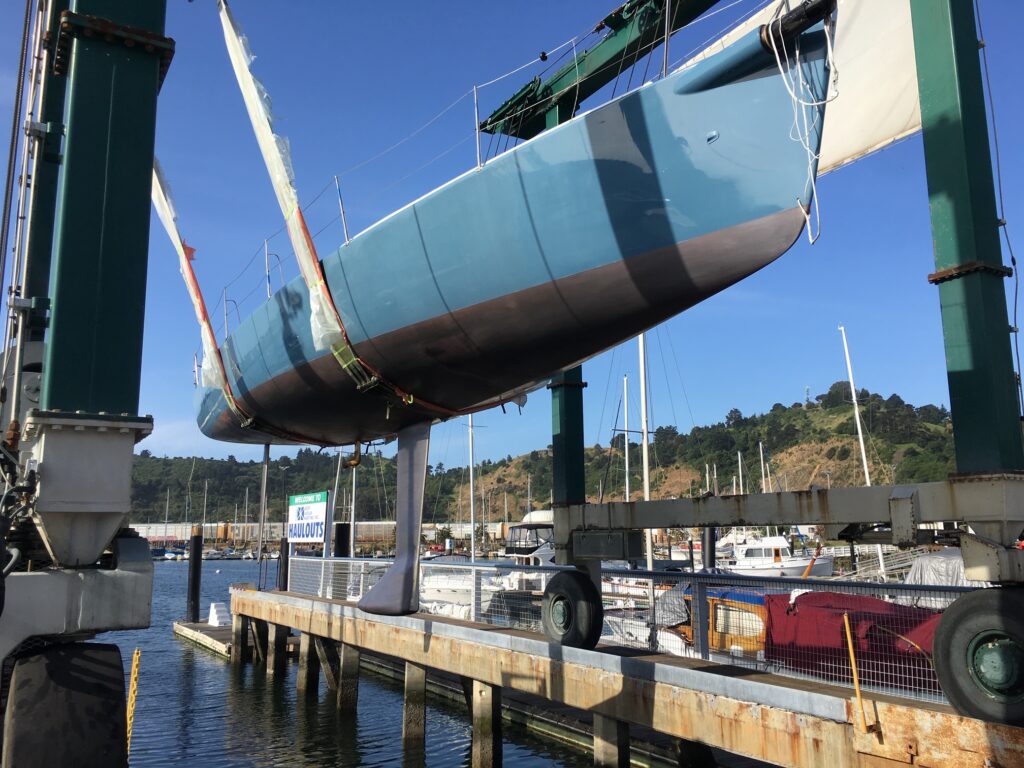
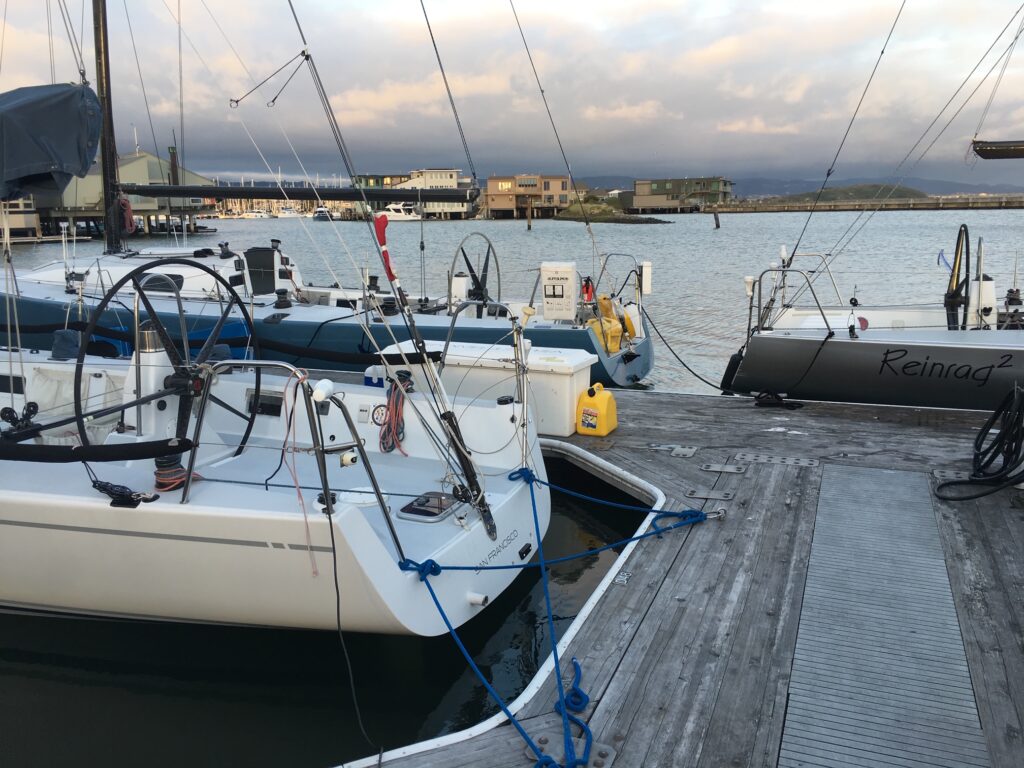
Southern California Delivery: It’s one thing to sail around the Puget Sound, and quite another to sail in the Pacific Ocean. As part of our crew training we decided to sail Hamachi from the Bay Area to Los Angeles to test the crew dynamic, boat and boat systems that would be required for the Transpac race. The prevailing southerly winds would provide good downwind training and the distance of 360nm ensured that the crew would establish a watch routine. There were several official races down the coast scheduled for late May (California Offshore Race Week) but it did not line up with the crew’s availability. We set out from the Richmond YC on Friday around mid-day and headed under the Golden Gate Bridge and pointed south for our delivery.
We beat upwind and then turned left headed south in a light westerly. The on watch crew was entertained by dozens of humpback whales breaching and frolicing in Half Moon Bay. The westerly continued to fade into a drifter and we motored through the night south towards Monterey before the northwesterly filled in and we were able to set the kite off of Point Sur. Over the course of the day the wind continued to build towards 20 kts and Hamachi rolled along at 14-16 kts boat speed.
One of the goals of this trip was to test our offshore drone flying. To this point I had never flown the drone (a DJI MavicAir) from Hamachi but wanted to try during Transpac. Hamachi rolls down the surf a few knots below wind speed so the relative (apparent) wind across the deck is very manageable for drone flying. We didn’t want our first attempt to be at sea that afternoon, so surfing downwind in 20 kts on our delivery seemed like a good time to try. I had a lot of anxiety about losing a $900 drone, but also have a “go big or go home” take on things, so we were very happy to get it back on board, as this video shows.
As afternoon turned to evening we approached Point Conception in building winds and seas. We doused the A2.5 and stowed the staysail, and hoisted the A4. By early evening the wind was steady at 22 kts and we downshifted to the A3 as we set up to pass beneath the Channel Islands. The wind continued to build and the waves became steep 6-10 ft rollers as we passed through shallow water. At 25-26 kts sustained Hamachi was overpowered and flying across and through steep waves, easily reaching 18 kts and setting a top boat speed of 20.5 kts. After several successive wipeouts in the gnarly conditions we doused the spinnaker and ran with just a full main, still hitting 17.5 kts surfing down steep 10 ft waves. The wind was squirrely, dying at times and then building to over 30 kts. We reefed the main and then wound up motoring for a while. As dawn broke the wind clocked around and Hamachi continued on under full main and J1, but eventually had to motor in to Marina Del Rey. The goal of the delivery was to bracket the range of conditions we might see on Transpac, and we accomplished that goal. The crew motored into the California Yacht Club confident in our boat and crew for doing the 50th Transpac.
All of the above must come together to have a successful campaign. It’s time consuming and expensive. On the Pacific Cup website it says that typical campaigns cost between $20-$60k with the option to spend as much as you want. The Hamachi campaign, which included: sponsorship, a tremendous amount of goodwill and generosity at all phases, and no new sails; is in the middle of that range.